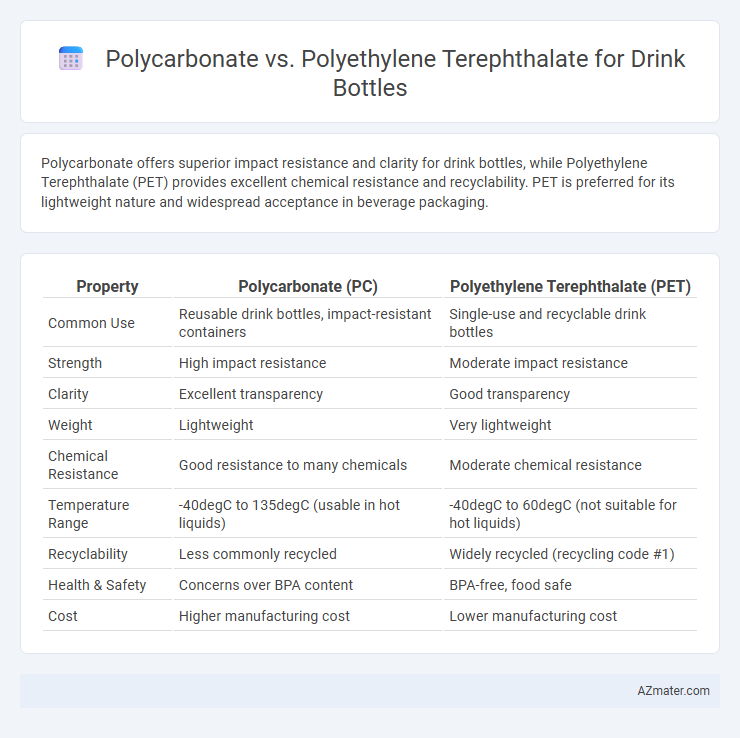Polycarbonate offers superior impact resistance and clarity for drink bottles, while Polyethylene Terephthalate (PET) provides excellent chemical resistance and recyclability. PET is preferred for its lightweight nature and widespread acceptance in beverage packaging.
Table of Comparison
| Property | Polycarbonate (PC) | Polyethylene Terephthalate (PET) |
|---|---|---|
| Common Use | Reusable drink bottles, impact-resistant containers | Single-use and recyclable drink bottles |
| Strength | High impact resistance | Moderate impact resistance |
| Clarity | Excellent transparency | Good transparency |
| Weight | Lightweight | Very lightweight |
| Chemical Resistance | Good resistance to many chemicals | Moderate chemical resistance |
| Temperature Range | -40degC to 135degC (usable in hot liquids) | -40degC to 60degC (not suitable for hot liquids) |
| Recyclability | Less commonly recycled | Widely recycled (recycling code #1) |
| Health & Safety | Concerns over BPA content | BPA-free, food safe |
| Cost | Higher manufacturing cost | Lower manufacturing cost |
Introduction to Polycarbonate and Polyethylene Terephthalate
Polycarbonate (PC) is a durable, transparent thermoplastic known for its high impact resistance and heat tolerance, making it suitable for reusable drink bottles. Polyethylene Terephthalate (PET) is a lightweight, clear polyester widely used for single-use and recyclable beverage containers due to its excellent barrier properties against gases and moisture. Both materials offer distinct advantages in drink bottle manufacturing, balancing durability, clarity, and environmental considerations.
Chemical Structure and Properties Comparison
Polycarbonate (PC) exhibits a bisphenol-A-based aromatic backbone and carbonate linkages, providing high impact resistance, excellent clarity, and thermal stability up to 150degC, making it ideal for reusable drink bottles. Polyethylene terephthalate (PET) is a polyester with ester functional groups formed from terephthalic acid and ethylene glycol, known for its excellent gas barrier properties, lightweight nature, and chemical resistance, commonly used in single-use and recyclable drink bottles. The rigid molecular structure of PC results in superior durability and heat resistance, whereas PET's semi-crystalline morphology offers better stiffness and moisture barrier performance, influencing their respective applications in beverage packaging.
Strength and Durability Differences
Polycarbonate (PC) exhibits superior impact resistance and toughness compared to Polyethylene Terephthalate (PET), making it less prone to cracking or breaking under stress in drink bottle applications. PET offers good tensile strength and rigidity but is generally more susceptible to deformation and surface scratching over time. The enhanced durability of PC supports longer-lasting, reusable bottles, whereas PET is more commonly used for disposable, lightweight drink containers.
Safety and Health Considerations
Polycarbonate (PC) drink bottles may release bisphenol A (BPA), a chemical linked to hormone disruption, especially when exposed to heat, raising safety concerns for long-term use. Polyethylene terephthalate (PET) is BPA-free and generally considered safer for beverages, although it can leach antimony under high temperatures or prolonged storage. Choosing PET bottles reduces the risk of chemical exposure, making them a preferred option for health-conscious consumers when it comes to drink containers.
Clarity and Aesthetic Qualities
Polycarbonate offers exceptional clarity with high light transmission and a glass-like appearance, making it highly desirable for premium drink bottles that emphasize transparency and visual appeal. Polyethylene terephthalate (PET) also provides good clarity but typically appears less glossy and can develop a slight haze after repeated use or exposure to heat. In terms of aesthetic qualities, polycarbonate's superior toughness supports sleek, durable designs, while PET's lighter weight and recyclability appeal to environmentally conscious consumers.
Environmental Impact and Recyclability
Polycarbonate (PC) and Polyethylene Terephthalate (PET) differ significantly in environmental impact and recyclability for drink bottles; PET is widely favored due to its lower carbon footprint and higher recycling rate, with an estimated global recycling rate of around 30%. PC, while durable and heat-resistant, presents challenges in recycling because it requires specialized facilities and often contaminates PET recycling streams, reducing overall efficiency. Choosing PET supports circular economy goals through established collection and processing infrastructure, minimizing landfill waste and reducing resource consumption.
Cost and Manufacturing Efficiency
Polycarbonate offers high durability and clarity for drink bottles but comes at a higher cost and requires more energy-intensive manufacturing compared to polyethylene terephthalate (PET), which is significantly cheaper and benefits from faster production cycles due to its easier moldability and lower melting point. PET dominates the beverage packaging market because it provides excellent efficiency in mass production, supporting high-speed bottling lines and effective recycling systems that reduce overall lifecycle costs. Cost-effectiveness and manufacturing scalability make PET the preferred choice for most drink bottle applications despite polycarbonate's superior toughness and temperature resistance.
Usability in Drink Bottle Applications
Polycarbonate offers superior impact resistance and clarity, making it ideal for reusable drink bottles that require durability and long-term use. Polyethylene terephthalate (PET) excels in lightweight, cost-effective, and recyclable options, commonly used for single-use and disposable drink bottles. PET's resistance to carbonation and chemical leaching ensures safety and freshness for beverages, while polycarbonate's higher heat resistance supports sterilization and microwave use.
Market Trends and Consumer Preferences
Polycarbonate and polyethylene terephthalate (PET) dominate the drink bottle market, with PET gaining preference due to its lightweight nature, recyclability, and lower production costs, driving significant market growth. Increasing environmental awareness and stringent regulations favor PET, as consumers prioritize sustainable packaging options and brands emphasize eco-friendly materials to meet demand. Despite polycarbonate's durability and clarity, concerns about BPA content are steering consumers and manufacturers toward safer, more sustainable PET alternatives.
Conclusion: Choosing the Right Material for Drink Bottles
Polycarbonate offers superior impact resistance and clarity, making it ideal for reusable drink bottles requiring durability and transparency. Polyethylene terephthalate (PET) excels in lightweight, cost-effective production and excellent chemical resistance, favored for disposable or single-use bottles. Selecting the right material depends on the balance between reusability, safety standards, environmental impact, and specific application needs.

Infographic: Polycarbonate vs Polyethylene Terephthalate for Drink Bottle
 azmater.com
azmater.com